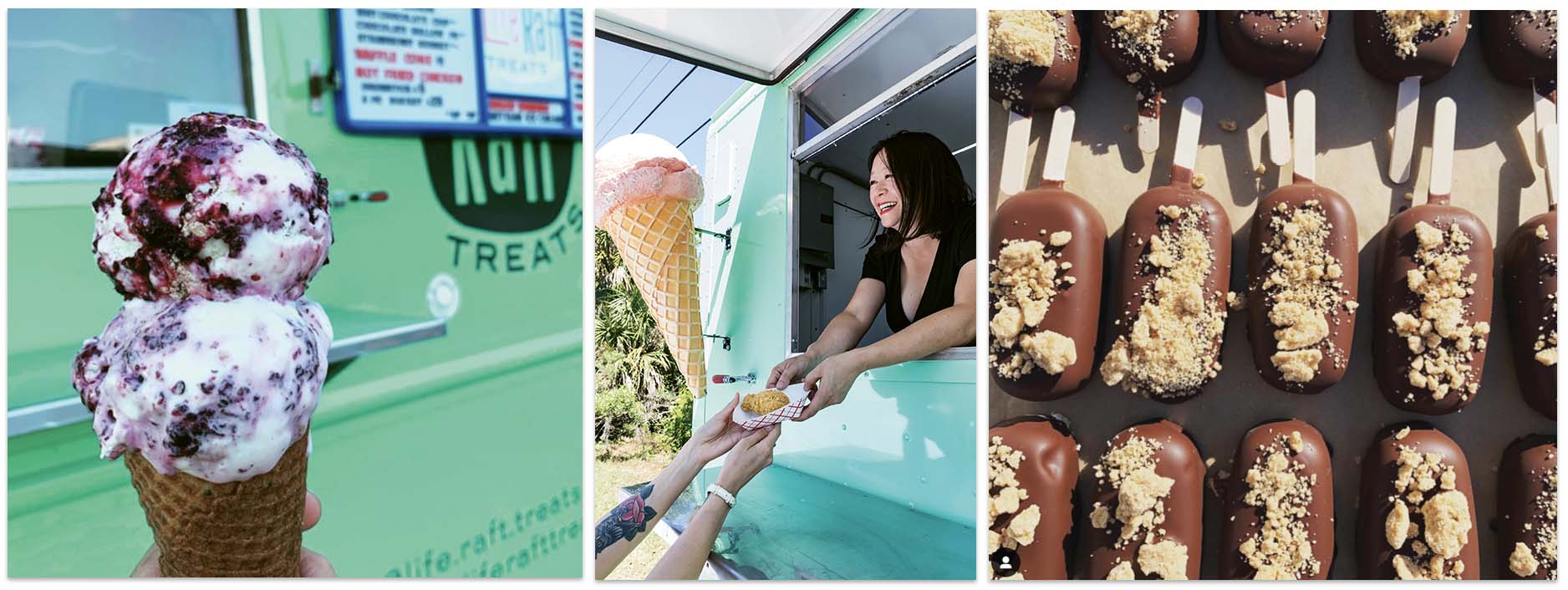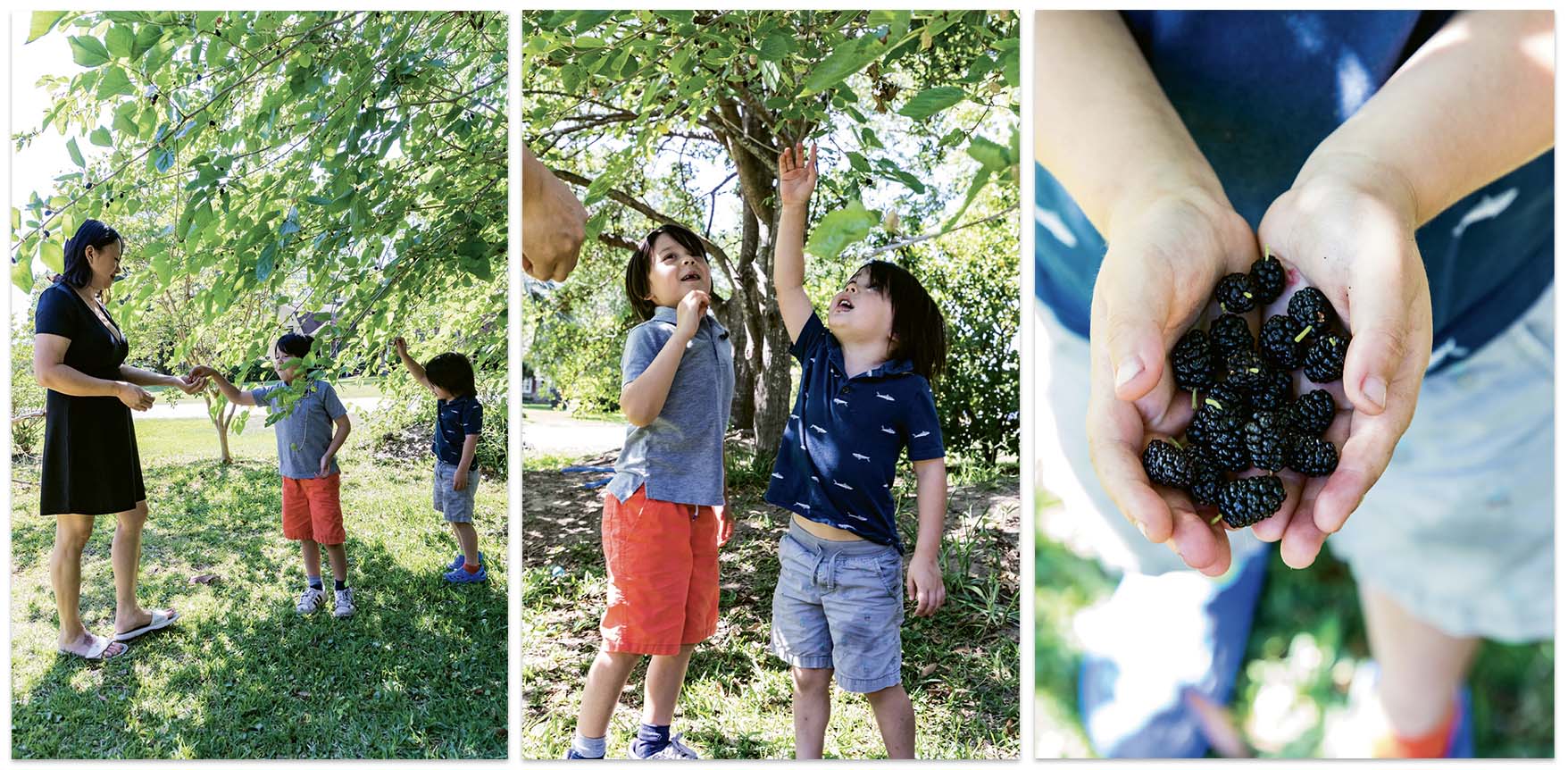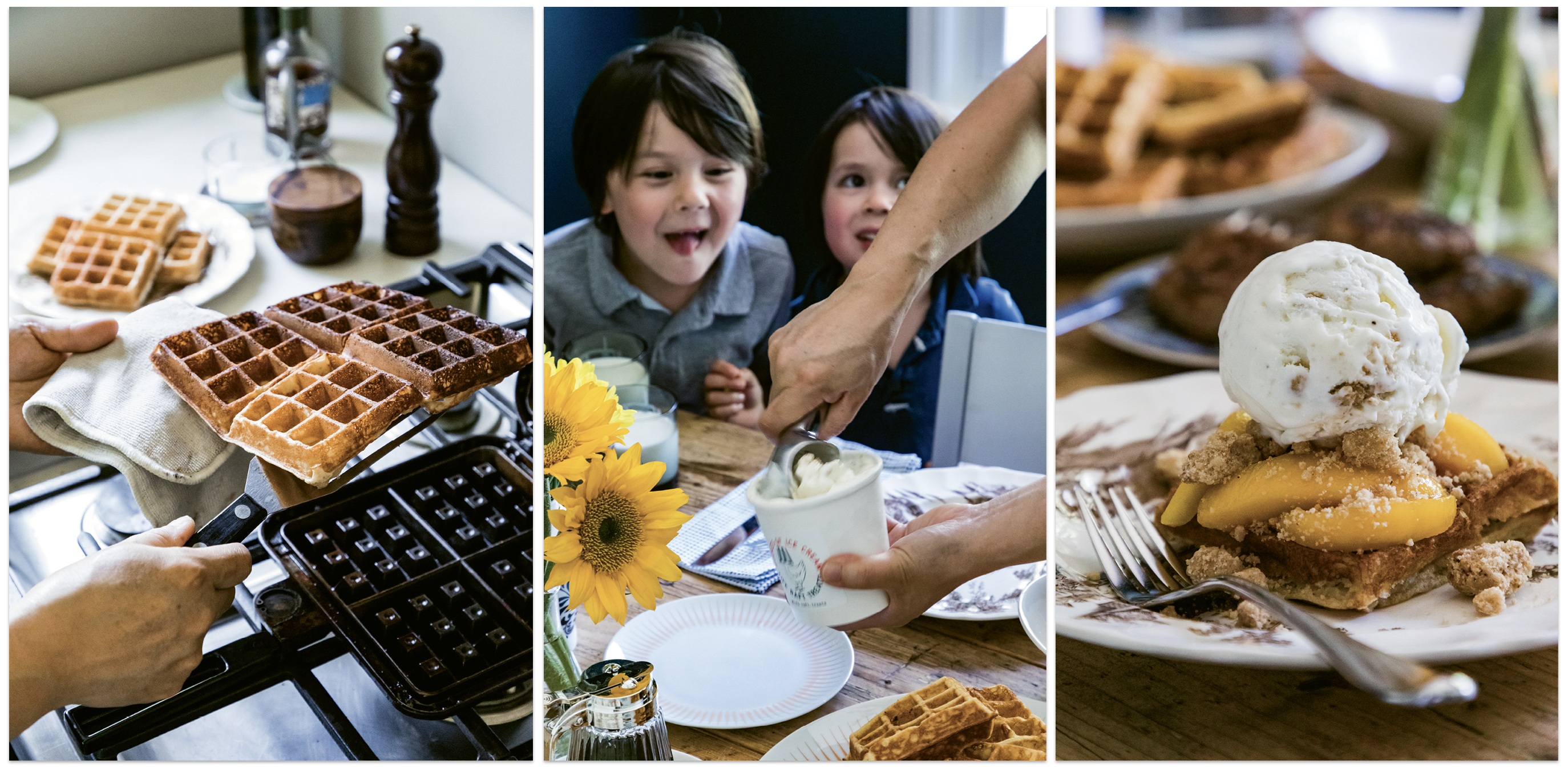How the Life Raft Treats owner and six-time James beard-nominated pastry chef Cynthia Wong is carving her own path in the culinary world, one scoop at a time

It’s noon at Island Plaza off Folly Road when a little boy waddles across the sprawling blacktop, hands outstretched to a pink, three-foot-tall ice cream cone. The fiberglass prop is affixed to the exterior of the Life Raft Treats truck—once a postal van that former Butcher & Bee pastry chef Cynthia Wong purchased at a government auction. After a cheery aqua-blue paint job and gut renovation, this parlor on wheels brightens the otherwise unremarkable strip mall, tractor-beaming customers of all stripes to its window. This afternoon, there’s a man buttoned up in business casual; a posse of young beachgoers smelling of patchouli (“We saw the truck and had to pull over!” one woman says); and that little boy who soon walks off triumphant, his excitement tamped just enough to keep the real ice cream cone in his hands from toppling.
This isn’t fodder for a Hallmark movie though. If ice cream could have an edge or wry sensibility, Wong has found it. Yes, sometimes her original scoops have cheeky names (think Sherbert Reynolds or Crunky Road). But with nearly a decade of pastry and baking experience, Wong brings a seasoned ease to Life Raft Treats—a kind of nuance made to seem effortless.
Take, for example, her now iconic Not Fried Chicken: the spitting image of a crispy, savory drumstick, fashioned with sweet waffle cone ice cream “meat” wrapped around a Cadbury cookie “bone,” and coated in a cornflake and caramelized white Dulcey chocolate crust. The construction of this “weaponized mouth joy,” as Wong calls it, leaves many smiling but stumped. How does someone even conceive of such an oddly exquisite confection?

(Left) Mulberry cheesecake scoops on a brown butter waffle cone; (middle) Wong serves a Not Fried Chicken; (right) babka bars
The answer: on the couch. As Wong recalls: “Half asleep, I thought, wouldn’t it be funny if I made something that looked like chicken but was actually ice cream?” Turned out, it would. Customers flock to wherever she’s parked, seeking Wong’s whimsical creations with limited-release, collector’s-edition-level enthusiasm.
The greater culinary world has taken notice, too. Wong’s humble operation earned her a 2019 James Beard Award nomination for Outstanding Pastry Chef (her sixth nod, and the first for Life Raft Treats). When recently named one of the “Cherry Bombe 100”—the fashiony food magazine’s top honor for influential industry women—Wong said she “double-checked it wasn’t a list of 100 Most Socially Awkward Asians, or 100 Bougiest Former Stoners Who Wish Someone Would Describe Them as the David Foster Wallace of Ice Cream.”
The mother of two is droll this way. But the story she’s writing is far more compelling, and generous, than some postmodern, existential screed. As she serves her magic shell-coated babka bars or rhubarb ripple blondies, you can hear the subtle music of her Mobile, Alabama, drawl. “I want to give someone a world to take with them,” Wong says. There’s a certainty in the way she speaks and carries herself—perhaps the same knowing sensibility that spurred her to walk away from restaurant life altogether and venture out on her own.
Around the World & Back Again
The youngest of three daughters, Wong was born in Charleston—to a Burmese housewife and Chinese physician—but grew up in coastal Alabama and Nashville. Her father hailed from particularly modest roots: a small, impoverished village in Guangdong Province (as Wong puts it, “You know, Angela’s Ashes but Chinese-style”).
Though raised in a strict immigrant household, she recalls a bucolic childhood: a quiet, mid-century ranch home; summers catching tadpoles in a nearby creek; the infinite strawberries she plucked from her parents’ exuberant garden. Then in her twenties, Wong followed a whim abroad, which prompted a stretch of formative globetrotting.

“My kids are the reason for all of this,” says Wong. Sonny, six, and Buck, four, help harvest mulberries. Wong uses the fruit in her mulberry cheesecake ice cream.
In France she attended culinary legend Gaston Lenôtre’s Ecole Lenôtre de Plaisir, where she learned pastry essentials, particularly the mathematical formulations vital to crème glacée. After a stint post-graduation translating French cookbooks, Wong wandered south to Barcelona where, in Spanish class, she met fellow Southerner, John David Harmon. Together they kept adventuring, first to Atlanta, then—after a Charleston elopement—London, with their newborn baby, Sonny, and rescued Blue Heeler, Critter, in tow.
But it was one summer trip to Île de Ré that altered her perspective entirely. At beloved ocean-side, family-run ice cream shop La Martinière, Wong encountered unexpected flavor combinations (potato and caramel, lemon meringue pie) and was struck by the playful yet immaculately crafted frozen treats (intricate brochettes skewered with tiny handmade marshmallows, cookies, cakes, and custards). Casual dessert had been altogether elevated, beyond plain vanilla scoops.
Wong would later aspire for a similar ethos with Life Raft Treats, but for the next several years, she focused on traditional restaurant work. The family returned to the States in 2014—first to Asheville where their son, Buck, was born. A year later, they relocated to Charleston, and Wong stepped in as Butcher & Bee’s head pastry chef. In addition to plated desserts, she managed commercial, wholesale, and retail operations for two restaurants, two café outposts, and three farmers markets. Never-ending dough lamination, service prep, deliveries, 4 a.m. start times, and 75-hour-plus work weeks had all become an untenable routine with two young sons. “I’d come home as the kids were getting into bed. Buck was only a year old,” says Wong. “Working was almost like a gambling addiction. I felt I was always just around the corner from finding the piece of the puzzle that would make it all click into place. So I kept going.”
Then late one night, she came home and the babysitter told her, “Your kids need you.” At first, she cut back her hours at Butcher & Bee but eventually decided to leave. “I realized I needed to be working that hard for myself—not for someone else,” she says. A month after quitting, she bought a mail truck and started hatching a plan.

“I use a vintage-ish Nordicware cast iron waffle iron I got on eBay. It’s one of my favorite pieces of cookware,” says Wong. “I love crumble. I try to put it on everything.”
The Story in the Scoop
Out on Island Plaza, Wong isn’t alone. Former FIG pastry chef Melanie Durant has been parking Scram (a breakfast sandwich truck with a cult following of its own) on James Island for two years. Life Raft Treats has frequently kept Scram company since March 2019, but the lotmates first met nine years prior in Atlanta, when Wong helmed pastry for Cakes & Ale and later Empire State South. Before Wong relocated to London, the women found themselves pregnant at the same time and grew close (“Cynthia made the best pregnant lady snacks!” recalls Durant.) When they reunited in Charleston, the chefs shared something different: the desire for a new way to work.
Durant launched Scram in 2017, inspiring Wong to begin her own mobile business a year later, but their admiration is mutual. “Cynthia made me feel it was okay to want more for my family and myself than my career,” shares Durant. “If it weren’t for her, I wouldn’t be here today.” It’s not all roses—there are dead generators and blazing summers in cramped trucks but also flexible hours, time with family, and full creative control. “For some women, success is a pie, and you need to get your slice of it. I don’t think that’s true,” says Wong. “I enjoy what I do, but I’m not going to die for my art.”
Post-beach rush, Harmon and the kids visit the truck. Sonny and Buck climb aboard in a flurry of Legos and idle chatter, still damp from swim practice. They peer into the flat-top cooler, eyeing the day’s kaleidoscopic flavors before Wong shoos them outside.
Throughout her work, the boys surface in subtle strokes. “Good food needs a good story,” notes Wong. “Otherwise, the experience can feel hollow.” Her sons love how Paddington Bear notoriously hides a marmalade sandwich under his wide-brimmed hat. So for her marmalade ice cream, Wong folds sweet brioche croutons into a vanilla base swirled with preserves, made from grapefruit that grows in her front yard. “My kids love climbing that tree,” she says. “In ways, it’s the life center of our family.”
This approach is perhaps one reason Life Raft Treats is exceptional to other parallel sweets purveyors today. Ice cream-making has become a popular mid-life career change for certain hobbyists with epicurean proclivities, perhaps due to the familiar nature of the medium. Ice cream is wholesome, universal; almost everyone can claim a deep, decades-long connection to it. With the right recipes, equipment, and funds, the learning curve appears deceptively straight. But expanding that hobby into a full-fledged business requires both savvy and skill. It’s how Wong knows the Second State coffee ice cream in her flavor Jamocha Me Crazy ought to have eggs (“I want the texture to be buttery, yolky, almost overwhelmingly decadent to balance out the bitterness,” Wong says), while the mulberry cheesecake—made with fruit from her yard, brown butter crumble, and a rich cream cheese base—does not. Can anyone make ice cream? Sure. But Wong has this down to a science.
“How’s the temp in the freezer, babe?” Harmon asks, surveying the truck. Between work trips as a fromager for wholesale grocery stores, he fixes mechanical bits and bobs (like installing that giant fiberglass cone) and partakes in all manner of kid-related duties. Most importantly, he handles the schmoozing—a part of the business that holds the least of Wong’s interests. “I’m actually very shy,” she admits.
Harmon chats with customers as the boys rally out front, wiggly with excitement. They know what time it is: chocolate cone for Sonny, a scoop of strawberry with hot fudge for Buck. A hush settles at the patio table, and they devour in silent communion. “I’m a strict mom, probably not as strict as mine was,” Wong says, watching the boys from afar. “But what’s the point in having an ice cream truck unless you can spoil your kids rotten?”

Breakfast at Harmon Manor: Local peaches, brown butter crumble, Storey Farms sausage patties, Anson Mills rice flour waffles, maple cheesecake ice cream
Harmon Manor
Home, a 10-minute drive from Island Plaza, is, to Wong, “the ugliest house on the prettiest block.” They chose the property for its sizeable wraparound yard, replete with decades-old fruit trees. There are 12 total—from figs to satsumas, pomegranates to peaches, plus a loquat sapling she planted last spring—that yield frequent inspiration. When in bloom, the trees’ nectarous scents waft into the street, signaling the imminence of spring.
With workdays that begin as early as 5 a.m. at a nearby commissary kitchen, Wong is all tapped out by supper: “Sometimes I think, ‘If I have to cook another thing today, I’m gonna have a nervous breakdown.’” Harmon usually fixes dinner—broiled salmon fillets with middlins and broccoli, or burgers and tots—while Critter mills about hopeful for crumbs.
Weekend breakfast is another story. “If the kids don’t get waffles, there’s a mutiny,” says Wong, with a smile. Indulging her sons is gratifying—a form of affection reminiscent of her own mother’s tender but measured gestures.
Wong often recalls a breakfast from her childhood, when her father attended a medical conference in New Orleans and the family made a trip of it. One morning, her ordinarily stern mother took the girls out for Belgian waffles à la mode. “This became a huge, formative moment for me,” says Wong. “I feel like immigrants, particularly ones who at some point struggled with food insecurity or were barely just removed from deprivation, love their children with food the way other parents can’t. Almost as if those who have always had plenty don’t even possess this sort of language.” The meal felt so extravagant at the time, and surprisingly effusive—a tangible expression of love.
Before heading out with the truck for weekend afternoons, Wong will sometimes rustle up a dish inspired by this memory. Her version involves Anson Mills rice flour, which renders the waffles airy and crisp with custardy centers. Life Raft Treats maple cheesecake ice cream is heaped on top, then showered with brown butter crumble. After breakfast, the boys burn off the sugar by climbing trees. They dangle and squeal, playing chase around the magnolia’s massive trunk, or by winding through the grapefruit branches, dodging pendulous fruit. Wong says they are endlessly astonished by the life of each plant, how they change and blossom. This is how she wants people to feel about food—giddy and awestruck, returning to a place of wonder.
Or maybe, as the name Life Raft implies, sweets can be a kind of rescue. Artwork for the truck reiterates this idea: the blissful man painted onto the back door, seated inside an “Ice Cream Shelter,” cone in hand; or the screenprint of an old-timey Louise Brooks-type, submerged in a sundae, tagline instructing, “Save yourself with a treat.” Which is to say, there are sacred things left in the world, so why not savor them? Yes, there are new challenges. Initial equipment and construction estimates for a future prep kitchen and retail space are astronomical. With wholesale batch pasteurization already in motion and plans for eventual expansion to Atlanta, she’s keeping busy, but working on her own clock. No-nonsense as ever, Wong believes “you just figure it out.”
For now, she’s pondering the little things. On occasion she’ll bare herself more than usual in a post online—in tidy ruminations that peek into her own story, as with this one reflection concerning the overgrown mulberry tree in her yard: “Before it started fruiting, I wanted to cut its scraggly ass down. True to form, I never got around to it, although I thought about it a bunch. And then one day I stomped outside for a look at all the plant life I wanted to obliterate—weeds, vines, gardenias gone totally wild, way too much ornamental ginger—and that mangy tree I wanted to uproot was lush and green and bent double with berries. Every time I pick berries from that tree, I am reminded to pause, breathe, and take a longer look at everything.”
Get Cynthia’s recipes for Waffles & Ice Cream here.
--------------
Local products & why she chose them:
- Lowcoutry Creamery Milk (“I want to taste the milk.”)
- Storey Farm Eggs (“Because I do everything by weight, I get to use all the random sizes no one else wants.”)
- Watsonia peaches for sorbet (“Delicious fruit-like you-re eating the peach itself. Nothing’s better when it’s too hot to think.”)
- Bulls Bay sea salt in all caramel
- Second State Coffee for coffee ice cream
- Black Pearl Farms blueberries for blueberry tres leches ice cream
- Crescent Farm carrots for carrot cake ice cream